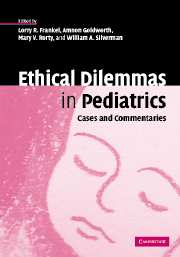Book contents
- Frontmatter
- Contents
- List of contributors
- Preface
- Introduction
- Part I Therapeutic misalliances
- Part II Medical futility
- 4.1 Letting go: a study in pediatric life-and-death decision making
- 4.2 Near-drowning, futility, and the limits of shared decision making
- 4.3 Topical discussion
- 5.1 Long-term ventilation in a child with severe central nervous system impairment
- 5.2 Autonomy, community, and futility: moral paradigms for the long-term ventilation of a severely impaired child
- 5.3 Topical discussion
- 6.1 Complexities in the management of a brain-dead child
- 6.2 The moral arena in the management of a brain-dead child
- 6.3 Topical discussion
- Part III Life by any means
- Part IV Institutional impediments to ethical action
- References
- Index
4.2 - Near-drowning, futility, and the limits of shared decision making
Published online by Cambridge University Press: 18 August 2009
- Frontmatter
- Contents
- List of contributors
- Preface
- Introduction
- Part I Therapeutic misalliances
- Part II Medical futility
- 4.1 Letting go: a study in pediatric life-and-death decision making
- 4.2 Near-drowning, futility, and the limits of shared decision making
- 4.3 Topical discussion
- 5.1 Long-term ventilation in a child with severe central nervous system impairment
- 5.2 Autonomy, community, and futility: moral paradigms for the long-term ventilation of a severely impaired child
- 5.3 Topical discussion
- 6.1 Complexities in the management of a brain-dead child
- 6.2 The moral arena in the management of a brain-dead child
- 6.3 Topical discussion
- Part III Life by any means
- Part IV Institutional impediments to ethical action
- References
- Index
Summary
Introduction
Suspended between life and death, this child is caught between his parents' hope and his physicians' growing despair. We know the facts of how he came to this point, but next to nothing about how his parents are coping with this sudden turmoil or to what dreams they still cling, nor are we shown how this particular drama ends. We do not know if this initial disagreement is resolved through further negotiations, as is almost always the case, or if it evolves into a stalemate, with family and physicians holding firm to conflicting positions.
Dr. Mathers gives a clear description of the process through which he helps families agree to withdraw life support for irreparably injured children. He clearly believes that responsibility for these important decisions should be shared between clinicians and the family. His concern for the well-being of the family is evident, and many clinicians could profit from his description of the importance of patience in negotiating with families. Nonetheless, the case history shows confusion about the roles of family and physicians. A careful look at the ethical and legal circumstances of the case suggests a better approach.
In this essay, I discuss the various forms of clinical decision making and conclude that the decision about discontinuing life support for JM must rest solely with the family, and in that sense is not shared at all.
- Type
- Chapter
- Information
- Ethical Dilemmas in PediatricsCases and Commentaries, pp. 95 - 107Publisher: Cambridge University PressPrint publication year: 2005
- 1
- Cited by

